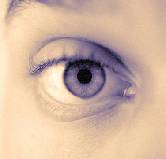
THURSDAY, Aug. 1 (HealthDay News) — You may never have heard of aniridia, a genetic disorder that robs people of their vision. But researchers studying the condition say it could give insight into some common health problems — from cataracts and glaucoma to diabetes and obesity.
Those researchers, along with doctors and aniridia patients, are gathering this week at the University of Virginia in Charlottesville for a conference on the latest advances in understanding aniridia.
People with aniridia lack an iris — the colored part of the eye surrounding the pupil. But that’s the least of their problems, said Jill Nerby, founder of the nonprofit Aniridia Foundation International, who is herself living with the disease.
“The lack of iris is what other people see, but that’s the least important part of this,” said Nerby, who was born with glaucoma, a potentially blinding eye disease that normally affects older adults.
Still, Nerby considers herself fortunate, because as a child she was able to get by with glasses, sitting in the front row at school and other tactics. Some with aniridia are legally blind at birth (20/200 vision or worse), or eventually have their vision deteriorate to that degree.
People with aniridia also typically develop other eye diseases — not only glaucoma, but also cataracts, damage to the cornea (the transparent membrane over the pupil) and disorders of the retina, the light-sensitive tissue in the back of the eye.
And the disorder does not stop at the eyes. People with aniridia often have metabolic disorders, including obesity, high blood sugar and diabetes. Some children develop a type of kidney cancer called Wilms tumor.
Aniridia is uncommon, affecting about one in every 40,000 to 100,000 newborns worldwide. But Nerby does not like to use the word “rare” in talking about aniridia.
“Yes, it’s unusual for all of these things — the glaucoma, cataracts, cornea scarring, diabetes — to be seen in the same person at a young age,” Nerby said. “But the conditions that we deal with are common.”
Yet, she said, back in 2001 when she started Aniridia Foundation International, there was little research and information on the condition. “You’d Google it, and all you’d find is that aniridia means ‘lack of iris,'” she said.
That, however, is changing. At the University of Virginia, considered a top research and treatment center for aniridia, Robert Grainger is studying a genus of frog called Xenopus to understand how eyes develop normally and what goes wrong when certain genes are mutated.
“Studies in animal models are absolutely critical for understanding the disease process,” Grainger said. The results of animal studies, however, often don’t translate directly to humans.
Mutations in a gene called Pax6 cause aniridia. Those mutations are either passed down from an affected parent or occur spontaneously. Nerby was the first in her family to be born with aniridia. Her son, now 24, also has it.
“Pax6 is essential in eye development,” Grainger said. “But it is also critical in the development of the central nervous system, and the pancreas and the gut.”
That wide-ranging role of Pax6 is why, researchers believe, people with aniridia often have metabolic disorders, including obesity, as well as other issues. One just coming to light is difficulty hearing, said James Lauderdale, an associate professor at the University of Georgia who studies aniridia.
“We think all of these things are directly or indirectly related to Pax6,” Lauderdale said.
Traditionally, aniridia has been seen as strictly an eye disorder. Patients have complained about other problems, such as weight gain, but they were never recognized as being related to the aniridia, Lauderdale said.
“It’s only in the past three to five years that we’re understanding that Pax6 may have a role in all of these [effects beyond the eyes],” he said. “We’re looking at aniridia more as a syndrome now.”
Both Lauderdale and Grainger said understanding the genetic underpinnings of aniridia could have “broad implications” for understanding all the common disorders that people with aniridia face.
But, Lauderdale said, the No. 1 goal is to aid people with aniridia. “The hope is to move toward some sort of approach that would correct the gene defect,” he said.
For now, treatment involves regular eye exams to spot problems like glaucoma and cataracts and treat them early. Even so, surgery is often necessary — and, Nerby said, people may have to travel to get it, since their local ophthalmologists may not be comfortable dealing with aniridia.
Since 2000, Nerby has had eight surgeries attempting to treat scarring of her corneas, which nearly all people with aniridia develop eventually. Those surgeries involved transplants, of either a donor cornea or primitive cornea cells called limbal stem cells. The problem is that those approaches often fail, and because of the donor tissue, patients have to take immune-system-suppressing drugs.
Last year, Nerby had an artificial cornea put in place. That’s a newer approach that experts hope will offer a better option since it does not require immune-suppressing drugs.
Another issue Nerby has faced is called aniridia fibrosis syndrome, an abnormal thickening and scarring of connective tissue throughout the eye. “With that,” she said, “you can lose your eye, not just your vision.”
No one is sure why it occurs, and one possibility is that it results from the many surgeries aniridic patients undergo. “We’re having these surgeries just to save the vision we have,” Nerby said. “So we need research to understand whether surgeries are contributing to [aniridia fibrosis syndrome].”
The approaches to managing aniridia are improving, Grainger said. “[But] we need them to keep getting better,” he said.
More information
The Aniridia Foundation International has more information on aniridia.
Copyright © 2025 HealthDay. All rights reserved.

